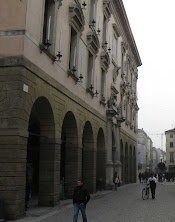Teacher to the nobility provided free education for poor children
 |
| Vittorino da Feltre treated his pupils as equal, wealthy or poor |
Da Feltre, who was originally named Vittore dei Ramboldini when he was born in Feltre in the republic of Venice in 1378, is thought to have established the first boarding school in Europe, a place of learning where the pupils enjoyed their lessons so much that it became known as La Casa Gioiosa - The House of Joy.
After studying and then teaching at the University of Padua, Da Feltre chose to settle in Padua and became a successful teacher, welcoming pupils into his own home, varying his fee according to the financial situation of the pupil’s family. He himself had come from a noble family that had become impoverished and his own early education had been difficult, but this had contributed to making him a strong and decisive character. He had also benefited from free tuition at the University of Padua.
In 1423, he was asked to become tutor to the children of the powerful Gonzaga family, who ruled over Mantua. He agreed to do this providing he could set up his own school away from the Gonzaga court and its political influence.
He also enrolled other children to be taught at the school along with the Gonzaga children, both noble and poor children, who were selected because of their ability. The poor children did not have to pay for their education and were taught on an equal footing with the children from wealthy families. He also educated girls and did not consider the female pupils to be inferior to the male pupils.
 |
| Palazzo Bo, the main building of the University of Padua |
Da Feltre saw education as a pathway to living a Christian life and made his pupils feel loved and cared for in terms of their health and characters. He adapted his teaching methods to their individual abilities and needs and never used corporal punishment. Among his students were Federico da Montefeltro, who became Duke of Urbino, and Gregorio Correr, who became Patriarch of Venice.
One of the first modern educators to develop during the Renaissance, Da Feltre’s teaching methods were therefore innovative and many other schools in Europe were to adopt his educational model.
During his career, Da Feltre not only educated future Italian rulers and professional men but also taught Latin and Greek scholars who came to him from the east. This paved the way for the translation of the Greek manuscripts that were to inspire the Renaissance in Europe.
Feltre School in Chicago, a private non-profit school, educates adults in English grammar, composition, public speaking, philosophy and the humanities. The name and philosophy of the school, which was founded in 1992, was inspired by the work of Vittorino da Feltre.
 |
| The town of Feltre, where Da Feltre was born, sits on a hill 20km from Belluno |
Feltre, where Vittorino da Feltre was born and from which he took his name, is a town in the province of Belluno in the Veneto. It is located 20 kilometres (12 miles) southwest of Belluno and there is a view of the Dolomites from the north of the town. The Cathedral, which was rebuilt during the Renaissance, has retained its 14th century campanile. It is flanked by a 15th century baptistery, which houses a precious, medieval baptismal font. There is an excavated archaeological area under the Cathedral revealing part of the Roman layout of the city. There is a statue of Vittorino in the main square, Piazza Maggiore.
.jpg) |
| The Palazzo Ducale was the seat of the Gonzaga family, rulers of Mantua |
Mantua, where Da Feltre worked, died and is buried, is an atmospheric ancient city in Lombardy, to the south east of Milan. It is famous for its Renaissance Palazzo Ducale, the seat of Da Feltre’s employers, the Gonzaga family, between 1328 and 1707. The palace is famous for its Camera degli Sposi, which is decorated with frescoes by Andrea Mantegna, depicting the life of Ludovico Gonzaga and his family. The beautiful backgrounds of imaginary cities and ruins are a reflection of Mantegna’s love of classical architecture.


